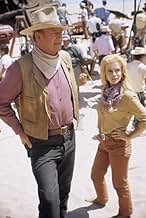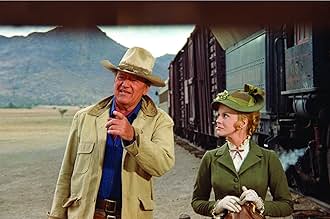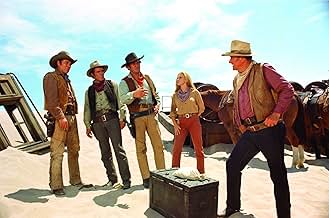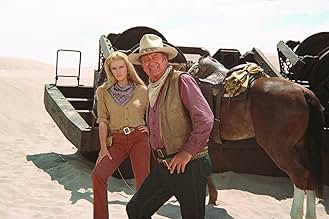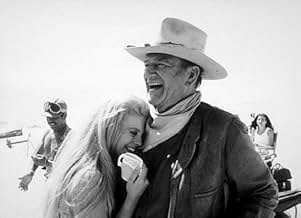NOTE IMDb
6,4/10
7,2 k
MA NOTE
Un tueur nommé Lane est embauché par une veuve, Mme Lowe, pour retrouver de l'or volé par son mari. Elle espère ensuite le rendre et pouvoir repartir de zéro.Un tueur nommé Lane est embauché par une veuve, Mme Lowe, pour retrouver de l'or volé par son mari. Elle espère ensuite le rendre et pouvoir repartir de zéro.Un tueur nommé Lane est embauché par une veuve, Mme Lowe, pour retrouver de l'or volé par son mari. Elle espère ensuite le rendre et pouvoir repartir de zéro.
- Réalisation
- Scénario
- Casting principal
Avis à la une
I know this film since I was a kid. Nothing new here. I watched it yesterday, once more. It could have been made by Andrew Mac Laglen. All these westerns made in the late 60's and early 70's, starring John Wayne and his pals, have nothing to do with the same period Sam Peckinpah's or Monty Hellman's ones, the new western, another kind. But I like the both. The new generation was more downbeat, the counter culture, the death of the old west. Wayne was thousand miles away from this. On the contrary, he was still in the old western, from the fifties and forties.
So, what could I say more about TRAIN ROBBERS?
I like this kind of westerns, and always will do.
Period.
So, what could I say more about TRAIN ROBBERS?
I like this kind of westerns, and always will do.
Period.
The film western had already been beaten dead for US audiences by the endless stream of television westerns. The vicious surrealism of the spaghetti western had essentially overwhelmed the clichés of Hollywood. What's a film maker to do? Clint Eastwood successfully made post-westerns by following the cynical, mysterious world-weary character he originated in the Leone films. What did everyone else do? Here's an example.
The film starts with a modest imitation of the masterful opening sequence of Leone's "Once upon a Time in the West" while some characters wait for Wayne to arrive on a train. When Wayne finally appears the film switches back into Hollywood style. The dialog is largely by the book and the characters are about as interesting as any you would find in an average TV western. The photography is very good but it can't make up for the fact that at least 20 minutes of the film are long boring scenes of John Wayne and his pals riding around on horses against spectacular vistas. Sometimes they are being followed by a mysterious group of hooligans who pass the same vistas, same camera shot!
The first 20 minutes of the film has no music but when Mr. Frontiere's orchestra kicks in (during those boring horse riding sequences), we are treated to bombastic western cliché music. Frontiere did some really good soundtracks elsewhere but this pales against much of Ennio Morricone's spaghetti western soundtracks.
To the film's credit there are some good sequences and dialog. The scene with a crashed train that's half buried in the desert is neat. And the last scene in the film is funny, almost makes up for the rest of the film. This could have been good but it would have had to be done in the 1950's when the western wasn't so pickled.
The film starts with a modest imitation of the masterful opening sequence of Leone's "Once upon a Time in the West" while some characters wait for Wayne to arrive on a train. When Wayne finally appears the film switches back into Hollywood style. The dialog is largely by the book and the characters are about as interesting as any you would find in an average TV western. The photography is very good but it can't make up for the fact that at least 20 minutes of the film are long boring scenes of John Wayne and his pals riding around on horses against spectacular vistas. Sometimes they are being followed by a mysterious group of hooligans who pass the same vistas, same camera shot!
The first 20 minutes of the film has no music but when Mr. Frontiere's orchestra kicks in (during those boring horse riding sequences), we are treated to bombastic western cliché music. Frontiere did some really good soundtracks elsewhere but this pales against much of Ennio Morricone's spaghetti western soundtracks.
To the film's credit there are some good sequences and dialog. The scene with a crashed train that's half buried in the desert is neat. And the last scene in the film is funny, almost makes up for the rest of the film. This could have been good but it would have had to be done in the 1950's when the western wasn't so pickled.
Late in his career, John Wayne made quite a few very leisurely films where he just kind of walked through the parts. Of course, considering he was pretty old and had been battling with cancer, it certainly isn't much of a surprise. What is a surprise is that he was, on occasion, able to play some of the roles he played--such as in BRANNIGAN and his final film, THE SHOOTIST. THE TRAIN ROBBERS is such a leisurely romp. Sure, they ride their horses a lot (probably too much, if you ask me), but the action scenes were pretty subdued other than a gunfight here and there and a couple punches--sort of a kinder, gentler sort of John Wayne.
This film is about a widow who wants Wayne and his friends to cross into Mexico to rescue some stolen gold and return it for the reward. Along the way, there are a lot of good moments of dialog between those in the party and, not surprisingly, the old professional Ben Johnson came off best in these scenes.
While the overall film offered few big surprises, the ending was pretty exciting and for Wayne fans this is a must-see. For others, it's a pleasant enough Western--you could certainly do a lot worse!
By the way--Two final comments. Bobby Vinton was in the movie but you'd hardly notice. Also, in one scene, a mule knocks one of them into a huge mud puddle. Only seconds later, the same guy is barely wet at all--an interesting continuity problem.
This film is about a widow who wants Wayne and his friends to cross into Mexico to rescue some stolen gold and return it for the reward. Along the way, there are a lot of good moments of dialog between those in the party and, not surprisingly, the old professional Ben Johnson came off best in these scenes.
While the overall film offered few big surprises, the ending was pretty exciting and for Wayne fans this is a must-see. For others, it's a pleasant enough Western--you could certainly do a lot worse!
By the way--Two final comments. Bobby Vinton was in the movie but you'd hardly notice. Also, in one scene, a mule knocks one of them into a huge mud puddle. Only seconds later, the same guy is barely wet at all--an interesting continuity problem.
The Train Robbers is written and directed by Burt Kennedy. It stars John Wayne, Ann-Margret, Rod Taylor, Ben Johnson, Christopher George, Bobby Vinton, Jerry Gatlin and Ricardo Montalban. Music is by Dominic Frontiere and cinematography by William H. Clothier.
Mrs. Lowe (Margret) hires Lane (Wayne) and his assembled crew to retrieve half a million U.S. dollars that her late husband stole during a train robbery. If they can find it and return it to the railroad, Mrs. Lowe will clear the family name and the Lane crew will pocket the $50,000 reward. However, there's also a considerably large posse out searching for the gold, and who is the strange man travelling alone observing things from afar?
A Technicolor/Panavision production filmed out of Durango in Mexico, The Train Robbers is small in plot but huge of entertainment heart. Gorgeously photographed by the highly skilled Clothier, director and writer Kennedy blends action, suspense and comedy as he straight out focuses on characterisations being expanded among the landscape beauty. With under ten speaking parts in the piece, and man made property kept to a minimum, it's very much a pared down production. This in no way hurts the film, in fact it's refreshing to see such an airy Oater, one that is made in the 70s but feels very much like a throwback to the 50s production line of Westerns.
The town of Liberty, Texas, forms the starting point for the movie, a near ghost town of a place, the arrival of the train bringing Mrs. Lowe and Lane feels like an intruder and accentuates the sparseness that will dictate the tone of the movie. Once the group head out into the wilderness it becomes about conversations and characters reacting to revelations born out by those conversations. In the distance is the heavy numbered posse out for the gold as well, but we only glimpse them like they are shifting ghosts of the terrain, they themselves intruding on the Lane group who as the journey unfolds start to bond and learn about life and each other.
Once the group locate the site of the stolen gold, it allows Kennedy and Clothier the chance to showcase some more striking imagery. Here out in the sand swept desert is what ultimately looks like a locomotive graveyard , the image is strong and it also signals the point where the film goes up a gear and the action enters the fray. All dusty paths then lead to an explosive finale and even as the dust settles we get a narrative twist that's very very cheeky. The cast are having fun, and hats off to Margret who manages to let her Mrs. Lowe character be more than just a honey-pot in the middle of mucho machismo.
I love The Train Robbers, I really do, it's beautiful to look at and features cast and characters that are so easy to warm to. Sure there's flaws and it's routine and hardly treads new ground at a time when the Western was on its knees and struggling to stand up. But it's made with love and respect for those genre fans willing to whisk themselves back to the heady days of the Western. While those moaning about The Duke's girth are very much missing the whole point of it all, both thematically and as a hat tipper to genre tropes. 8/10
Mrs. Lowe (Margret) hires Lane (Wayne) and his assembled crew to retrieve half a million U.S. dollars that her late husband stole during a train robbery. If they can find it and return it to the railroad, Mrs. Lowe will clear the family name and the Lane crew will pocket the $50,000 reward. However, there's also a considerably large posse out searching for the gold, and who is the strange man travelling alone observing things from afar?
A Technicolor/Panavision production filmed out of Durango in Mexico, The Train Robbers is small in plot but huge of entertainment heart. Gorgeously photographed by the highly skilled Clothier, director and writer Kennedy blends action, suspense and comedy as he straight out focuses on characterisations being expanded among the landscape beauty. With under ten speaking parts in the piece, and man made property kept to a minimum, it's very much a pared down production. This in no way hurts the film, in fact it's refreshing to see such an airy Oater, one that is made in the 70s but feels very much like a throwback to the 50s production line of Westerns.
The town of Liberty, Texas, forms the starting point for the movie, a near ghost town of a place, the arrival of the train bringing Mrs. Lowe and Lane feels like an intruder and accentuates the sparseness that will dictate the tone of the movie. Once the group head out into the wilderness it becomes about conversations and characters reacting to revelations born out by those conversations. In the distance is the heavy numbered posse out for the gold as well, but we only glimpse them like they are shifting ghosts of the terrain, they themselves intruding on the Lane group who as the journey unfolds start to bond and learn about life and each other.
Once the group locate the site of the stolen gold, it allows Kennedy and Clothier the chance to showcase some more striking imagery. Here out in the sand swept desert is what ultimately looks like a locomotive graveyard , the image is strong and it also signals the point where the film goes up a gear and the action enters the fray. All dusty paths then lead to an explosive finale and even as the dust settles we get a narrative twist that's very very cheeky. The cast are having fun, and hats off to Margret who manages to let her Mrs. Lowe character be more than just a honey-pot in the middle of mucho machismo.
I love The Train Robbers, I really do, it's beautiful to look at and features cast and characters that are so easy to warm to. Sure there's flaws and it's routine and hardly treads new ground at a time when the Western was on its knees and struggling to stand up. But it's made with love and respect for those genre fans willing to whisk themselves back to the heady days of the Western. While those moaning about The Duke's girth are very much missing the whole point of it all, both thematically and as a hat tipper to genre tropes. 8/10
I find The Train Robbers to be a surprisingly under-appreciated western. The more times I see it, the more I appreciate it myself. Sure, the feel and the look may be old-fashioned for its time but I don't care. Kennedy, Wayne and the rest of the group have obviously settled to make a fine basic western romp, not a new-styled masterpiece, and have reached the goal with very satisfying results. There can be seen a few little touches of Leone's 'Once Upon a Time in the West' (the first scene of Ben Johnson waiting at the train station), Siegel's 'Two Mules for Sister Sara' (a sister Sara-type treatment of the female character) or Hill's 'Butch Cassidy & the Sundance Kid' (the pursuing gang of riders). It also brings to mind Peckinpah's 'Ride the High Country'. But after these slight touches it's always back to the good old' Wayne stuff and I have nothing to complain about that.
With the music underlining heavily the handsome photography makes some highly iconic and beautiful pictures. There are frames that look a lot like classic western paintings. The nature and the people are seen beautifully during the long ride through deserts, rivers and storms. Sometimes it almost feels like watching 'Easy Rider' of the Wayne generation on horses. "Let's go to Mexico."
The action works fine like it always does when these old times film pros have been on the job. The men might be saddle-weary, but still gutsy enough and well worn like good saddle leather. You can tell the experience and good times as well from their voices. There is also a lot of warmth shining out of them, specially from Wayne's side. Ann-Margret has no real competition being the only woman in the picture. Besides "sticking out from the right places" she holds up pretty well especially with Wayne, who easily blew other actors aside with his strong presence on the screen.
With appropriately ironic note to its end the whole raid for the lost gold serves as a very good early seventies western and a decent one in Wayne's canon.
With the music underlining heavily the handsome photography makes some highly iconic and beautiful pictures. There are frames that look a lot like classic western paintings. The nature and the people are seen beautifully during the long ride through deserts, rivers and storms. Sometimes it almost feels like watching 'Easy Rider' of the Wayne generation on horses. "Let's go to Mexico."
The action works fine like it always does when these old times film pros have been on the job. The men might be saddle-weary, but still gutsy enough and well worn like good saddle leather. You can tell the experience and good times as well from their voices. There is also a lot of warmth shining out of them, specially from Wayne's side. Ann-Margret has no real competition being the only woman in the picture. Besides "sticking out from the right places" she holds up pretty well especially with Wayne, who easily blew other actors aside with his strong presence on the screen.
With appropriately ironic note to its end the whole raid for the lost gold serves as a very good early seventies western and a decent one in Wayne's canon.
Le saviez-vous
- AnecdotesDirector Burt Kennedy wanted to cast Jack Elam as Grady. However John Wayne would not allow this, because he felt Elam had stolen too many scenes from him in Rio Lobo (1970).
- GaffesDuring the era depicted, the price of gold in US dollars was fixed at $20.67 per troy ounce. $500,000 worth of gold would therefore weigh about 750 kg or 1,660 pounds avoirdupois - far too much for one man to shift or for one mule to carry, as depicted in different scenes.
- ConnexionsEdited into Ann-Margret: Från Valsjöbyn till Hollywood (2014)
Meilleurs choix
Connectez-vous pour évaluer et suivre la liste de favoris afin de recevoir des recommandations personnalisées
- How long is The Train Robbers?Alimenté par Alexa
Détails
- Durée
- 1h 32min(92 min)
- Mixage
- Rapport de forme
- 2.39 : 1
Contribuer à cette page
Suggérer une modification ou ajouter du contenu manquant


